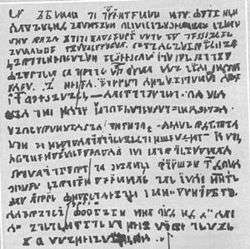Old Permic script
The Old Permic script (Komi: Важ Перым гижӧм), sometimes called Abur or Anbur, is a "highly idiosyncratic adaptation"[1] of the Cyrillic script once used to write medieval Komi (Permic).[2]
| Old Permic or Abur | |
|---|---|
 | |
| Type | alphabet
|
| Languages | Komi |
Time period | 1372–17th century |
Parent systems | Phoenician
|
| Direction | Left-to-right |
| ISO 15924 | Perm, 227 |
Unicode alias | Old Permic |
Unicode range | U+10350–U+1037F Final Accepted Script Proposal |
History
The script was introduced by a Russian missionary, Stepan Khrap, also known as Saint Stephen of Perm (Степан Храп, св. Стефан Пермский) in 1372. The name Abur is derived from the names of the first two characters: An and Bur. The script derived from Cyrillic and Greek, with Komi "Tamga" signs, the latter being similar in the appearance to runes or siglas poveiras because they were created by incisions rather than by usual writing. The inclusion of the latter aided the script to greater acceptance among the medieval Permic speakers of the time.
The script was in use until the 17th century, when it was superseded by the Cyrillic script. Abur was also used as cryptographic writing for the Russian language.
April 26, which is the feast day of Stephen of Perm, is celebrated as Old Permic Alphabet Day.
Significance

The Abur inscriptions are among the oldest relics of the Uralic languages. Only one of them has earlier documents: Hungarian, which had been written using the Old Hungarian script first before the Latin script was used after 1000.
For comparison, Finnish as a written language appeared only after the Reformation in 1543. However, an isolated birch bark letter, found in 1957 in Novgorod and written in a Finnic language, has been dated to the beginning of the 13th century.
Characters
Lytkin's 1952 work is often considered the authoritative source of documentation for this script.[3] There are 24 primary characters, along with 10 secondary characters that are subordinate to the primary characters. There are also some combining marks that may have been used for phonological purposes, in addition to some combining letters from Latin and Cyrillic that have been found as well. Spaces, middle dots, and semi-apostrophes have also been seen as punctuation in documents. A Cyrillic combining titlo is used to indicate numerals.
Unicode
Old Permic (U+10350–1037F) was added to the Unicode Standard in June 2014 with the release of version 7.0.
| Old Permic[1][2] Official Unicode Consortium code chart (PDF) | ||||||||||||||||
| 0 | 1 | 2 | 3 | 4 | 5 | 6 | 7 | 8 | 9 | A | B | C | D | E | F | |
| U+1035x | 𐍐 | 𐍑 | 𐍒 | 𐍓 | 𐍔 | 𐍕 | 𐍖 | 𐍗 | 𐍘 | 𐍙 | 𐍚 | 𐍛 | 𐍜 | 𐍝 | 𐍞 | 𐍟 |
| U+1036x | 𐍠 | 𐍡 | 𐍢 | 𐍣 | 𐍤 | 𐍥 | 𐍦 | 𐍧 | 𐍨 | 𐍩 | 𐍪 | 𐍫 | 𐍬 | 𐍭 | 𐍮 | 𐍯 |
| U+1037x | 𐍰 | 𐍱 | 𐍲 | 𐍳 | 𐍴 | 𐍵 | 𐍶 | 𐍷 | 𐍸 | 𐍹 | 𐍺 | |||||
| Notes | ||||||||||||||||
References
- Bernard Comrie, 1996. "Adaptations of the Cyrillic Alphabet". In Daniels & Bright, The World's Writing Systems, p. 700.
- Everson, Michael (2012-04-26). "N4263: Revised proposal for encoding the Old Permic script in the SMP of the UCS" (PDF). Working Group Document, ISO/IEC JTC1/SC2/WG2.
- Лыткин, В. И. 1952. Древнепермский язык: чтение текстов, грамматика, словарь. Москва
External links
- "Abur at Minority languages of Russia on the Net" (in Russian).
- "Abur". Omniglot.com.